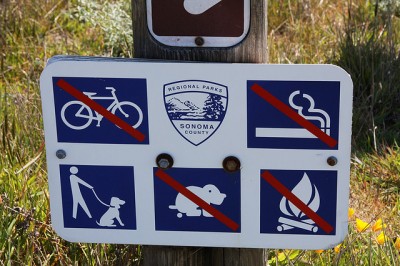
You do it everyday, but you don’t always think of what happens with it when you’re done – I’m referring, of course, to poop. In the wild, proper waste disposal should be of special consideration, since often there is no conventional disposal method. Improperly disposed human waste can lead to Giardia, which is the cause of “Beaver fever”, a 2 to 6 week case of diarrhea, abdominal cramps, nausea, and other unpleasantries.
Water sources are also polluted not only by human waste, but both livestock and wildlife. “Wherever soils are thin or sparse, such as the arctic tundra or above treeline, rainstorms can flush food wastes and other pollutants from campsites directly into water sources,” advises the Leave No Trace Center for Outdoor Ethics‘ “Outdoor Skills and Ethics”, which provided the basis for this article. With their help, I’ve put together a practical guide to disposing fecal waste in the wild.
- If there is a designated facility or outhouse, always use it.
- If you are in a primitive location where an outhouse is unavailable or far away, dig a cat hole where no human walks. With a trowel, spade or any other digging tool, dig a hole 6 to 8 inches deep, at least 200 feet away from any water source, your campsite, trails and other drainage. Do your deed and cover the hole back up with the soil you dug out initially.
- If you stay in that same area for a long time, make a different cat hole with each use. For groups, it is wise to have a personal “territory” to minimize the chances of accidental contact with a foreign cat hole.
“The microbes found in soil will break down feces and the pathogens they contain. Don’t leave human waste under rocks because it will decompose slowly there and may wash into water sources.” - For groups or those with children, digging a latrine might be a good option. “Site the latrine as you would a cat hole and make sure that the route to the latrine is over durable surfaces. Dig a trench 200 feet away from a water source, trail or campsite. Dig it 6 to 8 inches deep, and long enough to accommodate the needs of your party. Use soil from the trench to cover the feces after each use.” Cover the entire site with soil upon departure.
- Latrines are best when there are people without the necessary skills to use their own cat hole (like children) and “to concentrate the waste in one properly located place, thereby reducing the risk of water contamination and accidental direct contact.” Adversely, this reduces the decomposition rate, giving animals more time to find and scatter the remains. Latrines are designed for large groups staying in one area for a long time, or when camping with small children. Consider what best suits your needs before digging a latrine.
- In some terrains it is best to pack out your waste in sealable bags or a “poop tube”, which is a home-made or commercially-made device designed to transport human waste. Pack out or use a “poop tube” when you are in an area dense with waterways (visible water flow, even if it’s dry at the time), in areas where soil is thin or sparse (like the arctic tundra or above treeline), in alpine, in desert areas, on wintry, frozen ground or on rock where a cat hole cannot be dug. The contents of the “poop tube” can be discarded in pit toilets, portable johns, or in civilization. Check with the local land manager for recommendations on other appropriate disposal techniques.
As far as toilet paper goes, pack it out in a sealable bag, like a Ziploc. “Otherwise, use as little as possible and bury it deeply in the cat hole. Burning toilet paper at the site has caused wildfires…. and is not recommended.” Try to use biodegradable toilet paper to leave in the cat hole, if that is unavailable, at least don’t take perfumed or dyed toilet paper. “‘Natural’ toilet paper like grass, sticks and snow can be surprisingly effective.” Never leave feminine products in the wild because they take a long time to decompose and will attract animals.
This copyrighted information has been adapted and reprinted under special permission from the Leave No Trace Center for Outdoor Ethics © 2011. For more information on Leave No Trace, please visit www.LNT.org.
Photo: (sign) Jill Reed

 Your Privacy Choices
Your Privacy Choices
 The
The